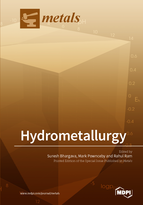Hydrometallurgy
A special issue of Metals (ISSN 2075-4701). This special issue belongs to the section "Extractive Metallurgy".
Deadline for manuscript submissions: closed (31 July 2015) | Viewed by 201638
Special Issue Editors
Interests: nanobiotechnology, resource utilization, applied electrochemistry, organometallic and supramolecular, catalysis and biocatalysis, sensors
Interests: applied/process mineralogy; experimental petrology and phase equilibria; geometallurgy; iron ore characterization and processing (beneficiation, agglomeration, sintering); ore mineralogy; materials characterization (SEM, EPMA, in situ XRD); heavy mineral sand deposits; uranium deposits; hydrometallurgy
Special Issues, Collections and Topics in MDPI journals
Interests: hydrometallurgy; minerals science; chemical engineering
Special Issue Information
Dear Colleagues,
Hydrometallurgy, which involves the use of aqueous solutions for the recovery of metals from ores, concentrates, and recycled or residual material, plays an integral role in the multi-billion dollar minerals processing industry. There are numerous hydrometallurgical process technologies used for recovering metals, such as: agglomeration; leaching; solvent extraction/ion exchange; metal recovery; and remediation of tailings/waste.
Modern hydrometallurgical routes to extract metals from their ores are faced with a number of issues related to both the chemistry and engineering aspects of the processes involved. These issues include declining ore grade, variations in mineralogy across the deposits and geo-metallurgical locations of the ore site; which would influence the hydrometallurgical route chosen. The development of technologies to improve energy efficiency, water/resources consumption and waste remediation across the circuit is also an important factor to be considered. Therefore, there is an increasing need to develop novel solutions to these existing problems, to implement environmentally sustainable practices in the recovery of these valuable metals.
Papers on recent advances, and review articles, particularly in regard to fundamental chemistry and the development of novel techniques and technologies in commercial processing of mineral commodities from their ores, are invited for inclusion in this Special Issue on "Hydrometallurgy".
Professor Suresh Bhargava
Dr. Mark Pownceby
Guest Editors
Manuscript Submission Information
Manuscripts should be submitted online at www.mdpi.com by registering and logging in to this website. Once you are registered, click here to go to the submission form. Manuscripts can be submitted until the deadline. All submissions that pass pre-check are peer-reviewed. Accepted papers will be published continuously in the journal (as soon as accepted) and will be listed together on the special issue website. Research articles, review articles as well as short communications are invited. For planned papers, a title and short abstract (about 100 words) can be sent to the Editorial Office for announcement on this website.
Submitted manuscripts should not have been published previously, nor be under consideration for publication elsewhere (except conference proceedings papers). All manuscripts are thoroughly refereed through a single-blind peer-review process. A guide for authors and other relevant information for submission of manuscripts is available on the Instructions for Authors page. Metals is an international peer-reviewed open access monthly journal published by MDPI.
Please visit the Instructions for Authors page before submitting a manuscript. The Article Processing Charge (APC) for publication in this open access journal is 2600 CHF (Swiss Francs). Submitted papers should be well formatted and use good English. Authors may use MDPI's English editing service prior to publication or during author revisions.
Keywords
- base metals
- uranium
- thorium
- gold
- silver
- mineral sands
- complex sulphides
- atmospheric leaching
- pressure leaching
- bio leaching
- heap leaching
- in-situ leaching
- solvent extraction
- electrowinning process
- bio-remediation
- waste removal
- hydrometallurgy







